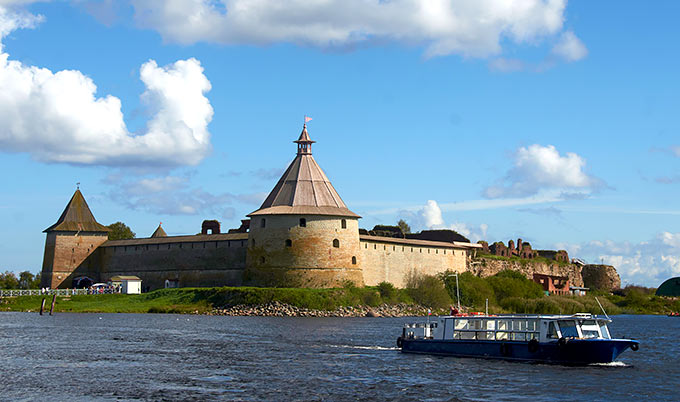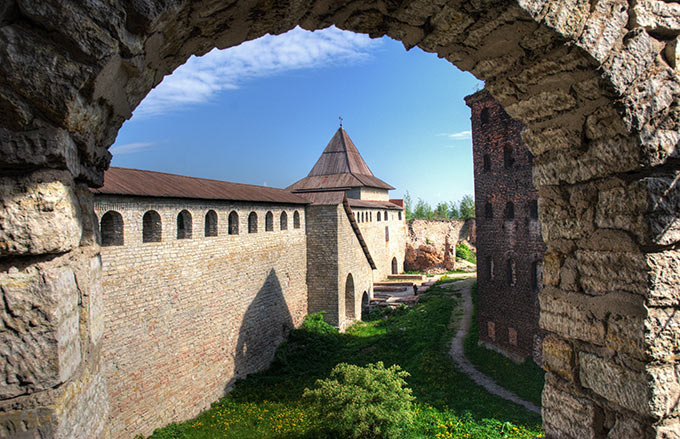History of Oreshek - Noteburg - Schlusselburg fortress
The fortress was built in 1323 by knjaz of Novgorod Jury Danilovich. The fortress name has obtained his origin from the form of island where it has been located - Oreshek (a nut). In 1352 - the first stone walls were erected. In the end of XV century the fortress was reconstructed and it had 10 towers, a citadel and internal channel-harbor.
In September 1611 the fortress was besieged by Swedes, and on May, 1612 russian garrison was forced to surrender. Swedes have renamed fortress Noteburg (Nut city).
During the Northern War on October 11, 1702, the fortress was full after 10-day bombardment by Russian army under command B.Sheremetev. Peter the Great took part in this storm as bombardment-captain. After that fortress was renamed again and became the Shlisselburg (Schlusselburg) that means "key city".
From the beginning of XVII century the Shlisselburg has lost its military value and began to use as a political prison. Members of imperial family, disgraced favorites, "decembrists", participants of the Polish revolt, member of terroristic organization "Narodnaja Volja" (People's Will) and other VIPs were prisoners of this fortress.
In February 1917 all prisoners were released by revolution people, prison buildings were burned and destroyed. From 1928 to 1940 the museum of Proletarian Revolution was here.
From 1941 to 1944 the front line passed through the fortress. Germans have not taken the fortress, but destroyed it severely.
In 1966 restore works have begun, Old and "New" (Narodovolcheskaja) prison have been restored. There are the exhibitions devoted to "decembrists" and "Narodnaja Volja" society members established here. Part of the fortress wall and three towers are restored too.
Impressions
This is the genuine ancient Russian fortress in one and half hour electric train journey from S-Petersburg city. The fortress is seen just from the electric train window, and this sight is very impressive. Entrance to the fortress is free of charge.
Inside of the fortress was quiet and uninhabited and very hot. There were the striped stall with sleepy saleswoman selling warm beer and the sleepy "muzhik" (local man) with scythe. The student's kind, hairy young people in sandals, rambled around the grassy fortress yard. The company of local men with hot local women and warm local beer was rested on the fortress wall. It was summer midday.
There are many places for climbing in the fortress, but protective helmet is strictly recommended because danger of collapse of the old walls. The numerous inscriptions inside the fortress say: "Restricted area! Danger of collapse!". It is true. Possibility to get a brick in your head is very high.
Impression as a whole is very good and warm in despite of rough history of this place. There was the most terrible prison in Russia, so even formidable revolutionaries went mad here and committed suicide (as it is written on memorial boards which fixed everywhere).
Land forts and fortress:
Bip Castle Gatchina Ivangorod Izborsk Kexholm Kirillov Monastery Koporye Novgorod Pechorskiy Monastery Peter&Paul Fortress Porkhov Pskov Schlisselburg Staraya Ladoga Tikhvin Vyborg Hameenlinna Hamina Kastelholm Kymenlinna Lappaenranta Raseborg Castle Savonlinna Tavetti Turku Visby Fredrikstadt Fredriksten Hegra Fort Hoytorp Fort Arensburg Narva Tallinn Antipatris Caesarea Jerusalem Latrun Fort Masada
Sea forts and fortresses:
Alexander Fort Ino Fort Krasnaya Gorka Fort Kronstadt: Kotlin isl. Kronstadt: North Forts Kronstadt: South Forts Trongsund Hanko Svartholm Sveaborg Marstrand Siaro Fort Vaxholm Oscarsborg
Artillery batteries and individual guns:
Coastal Artillery Hemso Fort
Fortified areas and defensive lines:
Karelian Fortified Area (KaUR) KrUR Leningrad Mannerheim Line Nevsky Bridgehead VT Line Harparskog Line Salpa Line Gothland
Russian
S e a r c h All news




